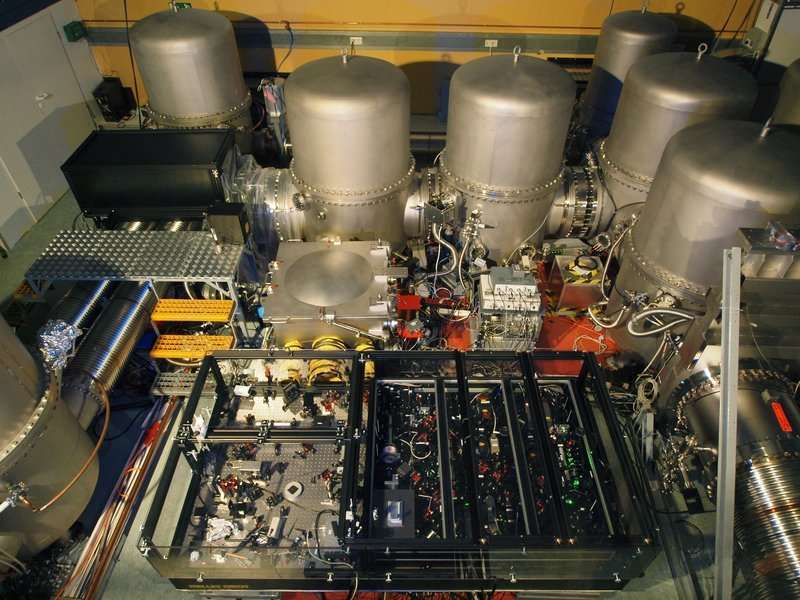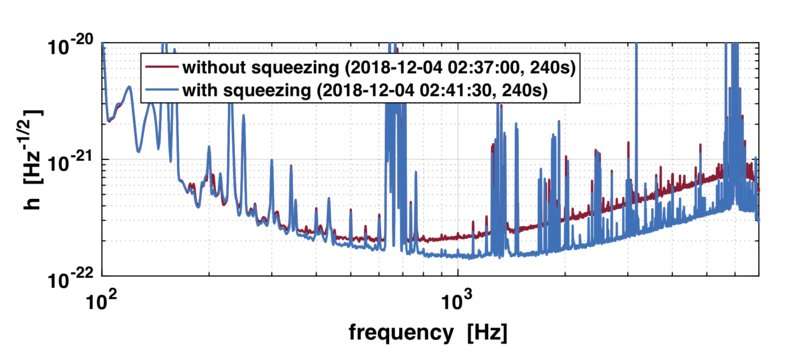The GEO600 squeezed light source (in the foreground) inside the GEO600 clean room together with the vacuum tanks (in the background).. Credit: H.Grote/Max Planck Institute for Gravitational Physics
The detection of Einstein's gravitational waves relies on highly precise laser measurements of small length changes. The kilometer-size detectors of the international network (GEO600, LIGO, Virgo) are so sensitive that they are fundamentally limited by tiny quantum mechanical effects. These cause a background noise which overlaps with gravitational-wave signals. This noise is always present and can never be entirely removed. But one can change its properties – with a process called squeezing, to date only used routinely at GEO600 – such that it interferes less with the measurement. Now, GEO600 researchers have achieved better squeezing than ever. This opens new ways to improve the international detector network in the next observation runs and is a key step to third-generation detectors such as the Einstein Telescope.
A marvelous new record
The team from the Max Planck Institute for Gravitational Physics (Albert Einstein Institute; AEI) and Leibniz Universität Hannover reached a squeezing level of 5.7 dB and therefore suppressed the quantum background noise by a factor of almost two. Compared to a detector without squeezing, this increases the observable volume of the universe by a factor of seven.
The research team employed newly designed optical components and tuned the optical setup of the squeezed light source and how it is coupled to the detector.
"With the current phase of interface upgrades complete, we've been able to start to fully optimize and characterize the system giving us this marvelous new record in squeezing, enhancing our sensitivity in frequencies important for understanding neutron star physics," says Dr. James Lough, lead scientist for GEO600.
Pioneering work at GEO600
"The GEO600 team has pioneered the use of squeezing in the international gravitational-wave community. Several generations of GEO600 Ph.D. students together with squeezing experts at AEI have made this breaktrough possible," explains Dr. Christoph Affeldt, GEO600 operations manager.
GEO600 background noise measurements. The transverse axis shows the frequency, the vertical axis the strength of the noise at these frequencies. The lower the curves are, the less noise is present and the better gravitational waves can be measured. The red curve shows the noise without the squeezed light source, the blue curve shows the noise with the squeezed light source. The improvements occur mainly at frequencies above several hundred Hertz, where gravitational wave signals from neutron stars are expected.. Credit: Max Planck Institute for Gravitational Physics
The German-British gravitational-wave detector GEO600 near Hannover has been routinely using a squeezed-light source since 2010 and has been the only instrument in the world to do so. The light source custom-made for GEO600 was developed and built at the AEI.
Together with the AEI colleagues, the GEO600 team has been continuously working to improve the integration of the "squeezer" into the detector. This is key because of the fragile nature of squeezed light: even a very small loss of it on its way into the detector limits the possible increase in sensitivity of GEO600. Therefore, many small improvements can result in large gains in sensitivity.
Squeezing in the next observation run O3
The sensitivity of all future interferometric gravitational-wave detectors will be increased through the use of similar squeezed-light sources. In the next common observation run O3 scheduled to begin in early 2019, both LIGO instruments and the Virgo detector will use squeezed light. The Virgo squeezer device is a newer version of the one developed for GEO600 and on permanent loan from the AEI.
"For future third-generation detectors like the European Einstein Telescope even higher levels of squeezing are required. With this amazing new record at GEO600, we are now ready to perfect this technology and tackle the next challenges on the way to the Einstein Telescope," says Prof. Karsten Danzmann, director at the AEI and director of the Institute for Gravitational Physics at Leibniz Universität Hannover.
Documentary about the development of the GEO600 squeezed light source
Provided by GEO600 Gravitational Wave Detector
























